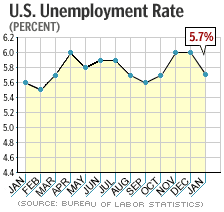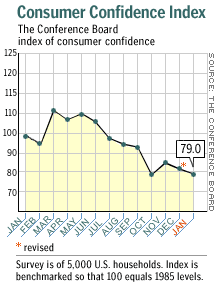NEW YORK (CNN/Money) - Friday's State of the Labor Market report from the government brought a bit of good news to Americans who've lately grown more accustomed to bad tidings, but the 8.3 million people unemployed in the United States shouldn't get their hopes up just yet.
Friday morning, the Labor Department said unemployment in January dropped to 5.7 percent from 6 percent in December and that employers added 143,000 jobs to non-farm payrolls after cutting a revised 156,000 jobs in December. Both the unemployment rate and the payrolls growth painted a much sunnier picture of the labor market than economists had expected.

Unfortunately, however, most of the jobs growth came from a quirk in the way the Labor Department adjusts for seasonal fluctuations in hiring. In December, it assumed retailers would hire several thousand workers for the holiday season. When retailer hiring was lower than expected, the seasonal adjustment spit out a December drop of 99,000 in retail payrolls.
The Labor Department further assumes that many of the people hired in December will be fired in January. Since fewer people were hired in December, it stands to reason that fewer people were fired in January, which could make the addition of 101,000 retail jobs in January over-inflated.
"Difficulties of seasonally adjusting the retail sector around year-end suggest that the two-month average -- about flat -- is a more reliable gauge of hiring trends," said Maury Harris, chief economist at UBS Warburg.
Signs of hope ... or false spring?
Seasonal quirks aside, some signs of hope in the labor market have appeared recently.
For one thing, the Conference Board's January consumer sentiment survey found the number of people who think jobs are easier to find may be growing slowly.
And the service sector -- the economy's biggest employer by far -- may be starting to hire again, according to the Institute for Supply Management's latest survey of business conditions among banks, health providers, retailers and other service industries.
"Hiring may be weak, but at least people are not losing their jobs" in the service sector, said Joel Naroff, president and chief economist of Naroff Economic Advisors in Holland, Pa.

But other labor market indicators have been less benign.
The Conference Board's Help Wanted Index, which measures help-wanted ad volume in 51 major U.S. newspapers, was lower in December 2002 than it was in December 2001, when the economy shed 197,000 jobs.
Meanwhile, U.S. companies announced 132,222 layoffs in January, according to Challenger Gray & Christmas, a 42 percent jump from December. In the past six months alone, companies have announced 746,781 job cuts -- more cuts than are announced in most full years, the Chicago outplacement firm said.
And new weekly claims for unemployment benefits continue to hover just below 400,000, the level many economists say is the dividing line between a recovering labor market and a lousy one.
"There's nothing in the tea leaves telling us we'll be seeing much labor-market buoyancy for several months," said Merrill Lynch chief economist David Rosenberg.
Is Iraq keeping you unemployed?
The timing of a labor-market rebound depends largely on how corporate executives view a possible -- some say inevitable -- war with Iraq.
Most economists, including Federal Reserve Chairman Alan Greenspan, think businesses are waiting to see what happens in Iraq before making big plans for spending and hiring. Clear up the war in Iraq, the thinking goes, and you solve the problem with the labor market, especially since oil prices will probably fall, easing the burden on businesses and consumers.
"Iraq will be the story until it isn't any more," said Steven Wieting, senior economist at Salomon Smith Barney -- which, incidentally, came the closest of 22 firms polled by Reuters to predicting Friday's drop in unemployment and jump in payrolls.
But some economists suspect the economy has another ailment -- namely, the hangover effect of the stock-market and investment bubble of the late 1990s.
When that bubble popped, it left a huge mess for corporate America to clean up. Businesses have a glut of unused production capacity, meaning they're not inclined to invest much more in new plants or new people. Falling stock prices have crippled balance sheets, making the debt companies took on in the good old days more burdensome.
And the prolonged economic slowdown has been murder for corporate pricing power. With sluggish demand and little or no ability to raise prices, it doesn't take an economic genius to figure corporate profits have been sluggish at best.
So companies have been forced to keep costs down, and the easiest cost to cut is labor. More than 2.3 million private sector jobs got cut in 2001 and 2002, and it could take a while for those jobs to come back, war or no war.
"It's a little bit analogous to the early 1990s, in that, when the Persian Gulf War ended then, the economy did not come storming back -- it took a while because it continued to work off its problems," said Joshua Feinman, chief economist at Deutsche Bank Asset Management. "Something similar could happen this time, though the economy is a little further along now in its process of unwinding than it was then."
| 
| |

| 
| 
|

|
 CNNfn's economic corespondent Kathleen Hays takes a closer look at the productivity of U.S. workers and the economy. CNNfn's economic corespondent Kathleen Hays takes a closer look at the productivity of U.S. workers and the economy.
|
|
Play video
(QuickTime, Real or Windows Media)
|
| 
|

|
|
Fortunately for corporate profits, businesses have been able to milk more work out of fewer workers, the result being productivity -- a measure of output per hour -- rose 4.7 percent in 2002, the best performance since 1950.
Though productivity fell back to earth in the fourth quarter, along with a dip in economic growth to a rate of just 0.7 percent, few economists doubt productivity's long-term trend is anything but good for business.
"I think this is just a hiccup in a very strong trend that we expect to continue," Anthony Crescenzi, bond market strategist with Miller Tabak & Co., told CNNfn's CNNmoney Morning program.
Higher productivity will eventually boost profits, since it lets companies get more from their existing work force; and that will bring more hiring when the economy finally starts gathering some steam -- whenever that might be.

|

